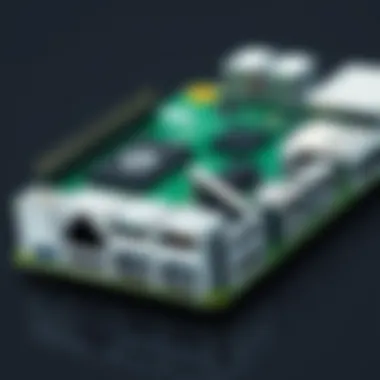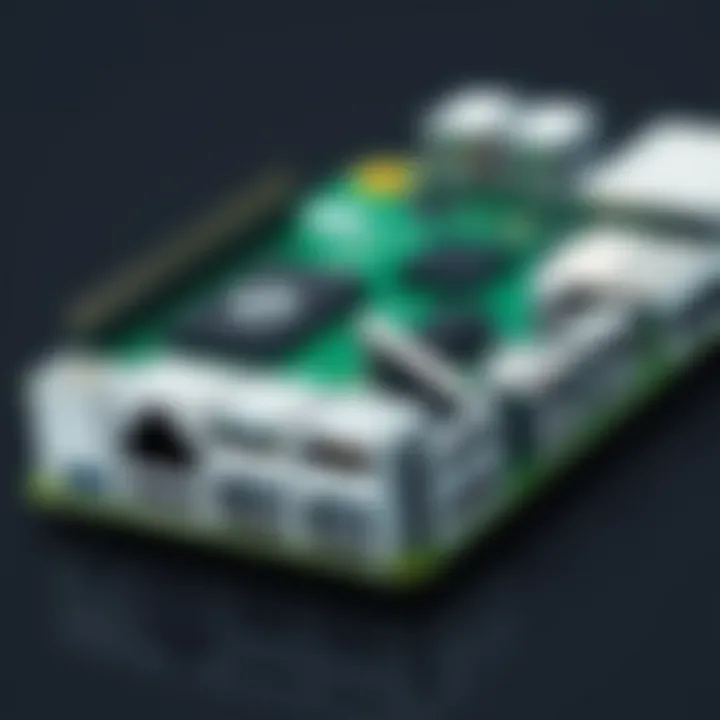Exploring the Raspberry Pi 4 Model B: Features and Uses


Intro
Within the evolving landscape of technology, the Raspberry Pi 4 Model B stands out as a beacon of innovation, simplicity, and versatility. It's not just a DIYer's dazzling toy or a teacher's helping hand; it's a robust platform that fosters creativity, learning, and experimentation. As we peel away the layers, we'll dive into its specifications, performance, and real-world applications. By examining what makes this little powerhouse tick, we can appreciate its role in bridging the gap between concept and application.
The Raspberry Pi community continues to grow, fueled by enthusiasm and extensive resources. From tinkerers in their basements to educators in classrooms, the range is astonishing. But is the latest version worth the hype? This guide aims to illuminate key aspects that define the Raspberry Pi 4 Model B, setting it apart from its peers, while also exploring how its features can be leveraged across various fields.
As we embark on this journey, we’ll not just skim the surface. Expect a thorough understanding of its capabilities, insights into how it stacks against competitors, and perspectives on both its strengths and drawbacks. Let's begin.
Preface to Raspberry Pi Model B
The Raspberry Pi 4 Model B marks a significant leap in the evolution of single-board computers. Its importance cannot be overstated, especially for tech enthusiasts, educators, and professionals who seek an affordable yet powerful tool for various applications. With improved processing capabilities, increased memory capacity, and enhanced connectivity features, this model opens the door to a host of possibilities. Whether you're looking to tinker with robotics, develop software, or even power a home media center, the Raspberry Pi 4 Model B emerges as an attractive option.
Historical Context
To really appreciate the Pi 4, we should take a look back. Raspberry Pi started as a project to encourage teaching of basic computer science in schools. The first model, launched in 2012, was a simple device with limited capabilities. However, it caught the imagination of hobbyists and educators alike, leading to a robust community sharing projects and ideas. Fast forward to 2019, and the Raspberry Pi 4 Model B revolutionized the game. It offered up to 8GB of RAM and a powerful ARM Cortex processor, enabling users to work on more sophisticated applications than ever before. The transition from educational tool to versatile platform is a testament to its growing role in computing and innovation.
Objectives of the Article
This article aims not just to inform, but to create a comprehensive guide into what the Raspberry Pi 4 Model B has to offer.
- Highlight the technical specifications that set it apart from previous models.
- Explore its various applications, catering to both beginners and seasoned experts.
- Review community resources that enhance learning and project development.
By the end, readers will walk away with a clear understanding of this remarkable device, along with insights into its potential impact on future technological innovations. The goal is to arm you with knowledge—whether you are a hobbyist or an industry professional, the Raspberry Pi 4 Model B has something for everyone.
Technical Specifications
Understanding the technical specifications of the Raspberry Pi 4 Model B is crucial for anyone considering to dive into this compact powerhouse. These specifications not only dictate the device's capabilities but also define its utility across various applications, from hobby projects to professional implementations. Recognizing the importance of these elements can greatly influence how one might choose to harness the potential of this device.
Processor and Performance
At the heart of the Raspberry Pi 4 Model B lies the Broadcom BCM2711 processor. This quad-core ARM Cortex-A72 chip runs at 1.5 GHz, providing a noticeable leap in computational power compared to its predecessors. The upgrade offers a significant boost in performance, which is particularly beneficial for running resource-intensive applications and multitasking.
The improvements in performance make this model suitable for a variety of tasks that would strain older versions. For instance, tasks like media playback at higher resolutions, gaming emulation, or even serving as a home server become much more feasible. The processing capability also enhances responsiveness, translating to a smoother user experience.
In benchmarking tests, it consistently outperforms the Raspberry Pi 3 Model B+ by approximately three-fold in certain CPU tasks, which is a game changer for developers looking to push the envelope of what single-board computers can achieve.
Memory and Storage Options
The Raspberry Pi 4 Model B comes equipped with several memory options, ranging from 2GB to a whopping 8GB of RAM. This flexibility is exemplary in catering to diverse use cases. For basic tasks such as web browsing or learning programming, the 2GB variant suffices. However, the 8GB model opens doors to robust applications, enabling users to run full-fledged operating systems and even virtual machines.
Storage-wise, it utilizes a microSD card as its boot device. However, unlike earlier models, the Raspberry Pi 4 also supports booting from USB drives, which is a noteworthy enhancement. This gives users the ability to expand their storage easily, offering quicker data access and improved speed compared to traditional microSD cards.
Key features to note:
- Memory: Options of 2GB, 4GB, and 8GB RAM.
- Storage: microSD card slot and support for USB booting.
- Speed Considerations: USB 3.0 ports allow faster data transfer rates.
Connectivity Features
Connectivity is another strong suite of the Raspberry Pi 4 Model B. It boasts dual-band 802.11ac Wi-Fi and Bluetooth 5.0, making it versatile for various networking applications. Whether it’s connecting to a local network or communicating with other Bluetooth devices, the Raspberry Pi is well-equipped.
It includes two USB 3.0 ports and two USB 2.0 ports. The introduction of USB 3.0 is significant, allowing for faster peripherals and improved data transfer rates, which is critical for applications such as external drive access or high-speed peripherals.
Furthermore, the Raspberry Pi 4 includes a Gigabit Ethernet port, offering a reliable and speedy wired connection, ideal for setting up on a network without the hassle of Wi-Fi reliability issues.


In summary:
- Wi-Fi: Dual-band 802.11ac.
- Bluetooth: Bluetooth 5.0.
- USB Ports: Two USB 3.0 and two USB 2.0.
- Ethernet: Gigabit ports supplies fast connection.
Overall, the technical specifications of the Raspberry Pi 4 Model B set a benchmark in the realm of single-board computers. These components create opportunities for diverse applications and, ultimately, elevate the user experience, marking it as a tool worth considering for a wide array of projects.
Physical Design
When discussing the Raspberry Pi 4 Model B, the physical design plays a fundamental role in understanding its usability and integration into various applications. The dimensions, shape, and overall aesthetics of the board dictate how users will interact with it, how it fits into existing setups, and even how it can be utilized in innovative projects.
Form Factor and Dimensions
The Raspberry Pi 4 Model B sports a compact and convenient form factor, measuring approximately 85.6mm x 56.5mm x 19.5mm. This small size is a boon for creators looking to integrate this device into tight spaces without compromising power or performance. The sleek, low-profile design also leaves room for effective heat dissipation, which is particularly important given the performance capabilities of this model.
Users appreciate the board's port arrangement as well. USB ports, HDMI outputs, and the Ethernet port are strategically placed along one edge, facilitating easier connections and neater cable management. Furthermore, its mounting holes are in standard locations favored by hobbyists for securing the board to various enclosures or mounts, preventing any unfortunate slips or accidents during use.
- Compact Dimensions: Highly adaptable to various projects.
- Strategic Port Layout: Easier cable management.
- Standard Mounting Holes: Universally compatible with common enclosures.
One notable point is that the heat management of the Raspberry Pi 4 Model B must be carefully considered. The device can run hotter due to its superior performance, making it crucial to ensure an adequate airflow or the addition of heatsinks for extended use. Overall, the physical design of the Raspberry Pi 4 aligns well with its purpose as a versatile computing platform, promoting functionality without sacrificing style.
Power Supply Requirements
Another aspect that users must take into account is the power supply requirements of the Raspberry Pi 4 Model B. The device operates on 5V/3A power, which essentially means that not just any power source will do. Users often overlook this detail, thinking that any old USB charger can suffice. However, under-delivering on power can lead to performance issues or even cause the board to become unstable during heavier tasks.
To ensure optimal function, it’s advisable to use a dedicated power supply unit designed for the Raspberry Pi. A USB-C connector is employed, which not only improves the device's ability to handle modern peripherals but also allows higher power delivery compared to previous models. This adaptability allows users to connect the board to a variety of power sources without hassle.
- 5V/3A Requirement: Essential for stable operations.
- USB-C Connector: Supports modern power delivery standards.
- Dedicated Power Supplies: Recommended for optimal performance.
One point of caution: while testing out the board with alternative power sources, users have reported issues such as random shutdowns or erratic performance. Hence, sticking to recommended power supplies ensures both safety and efficiency in operation, allowing enthusiasts to focus on creating rather than troubleshooting.
In summary, the Raspberry Pi 4 Model B’s physical design is not just about looks; it’s a comprehensive system that encourages optimum performance and ease of use through thoughtful arrangement and specific power requirements.
Operating System Compatibility
Operating system compatibility is a vital cornerstone for the functionality of the Raspberry Pi 4 Model B. This little marvel, while compact in size, is a powerhouse when it comes to versatility. It can cater to a range of users from hobbyists to professionals. Therefore, understanding what operating systems are compatible with this board is essential for maximizing its potential and ensuring smooth operation.
Official OS Options
The Raspberry Pi Foundation has made it straightforward for users by offering several official operating systems that can be easily installed. The most prominent among these is Raspberry Pi OS, previously known as Raspbian. This Debian-based OS is optimized specifically for the Raspberry Pi hardware. It features a lightweight desktop environment, making it responsive even on lower-powered devices.
A few key pointers regarding the official OS options:
- Performance Optimization: All official operating systems are tailored to utilize the hardware effectively, ensuring users get the best performance.
- Regular Updates: These OS options frequently receive updates from the Raspberry Pi Foundation, which improves security and fixes bugs promptly.
- User-Friendly Interface: Browsing, coding, or executing instructions is made easier thanks to the intuitive UI design.
Moreover, there are other official options like LibreELEC, a popular choice for media center applications. This OS allows users to set up a home media center with Kodi, thus transforming the Raspberry Pi 4 into a powerhouse for streaming and local media playback.
Third-Party OS Environments
Beyond official choices, the realm of third-party operating systems expands the horizons of Raspberry Pi 4 Model B capabilities. These OS environments offer various features tailored to specific needs or projects, providing more flexibility and enhanced functionality.
- Ubuntu Server: Ideal for users looking for a robust server setup. It is relatively lightweight and provides extensive support, allowing it to serve multiple applications from web servers to game servers.
- Kali Linux: This specialized distribution suits cybersecurity professionals and ethical hackers. It comes pre-loaded with numerous tools, making it perfect for penetration testing and security assessments.
- RetroPie: For gaming enthusiasts, RetroPie allows users to turn their Raspberry Pi into a retro gaming console. It supports a wide variety of classic games and emulators, providing a nostalgic experience.
- OpenMediaVault: This OS is excellent for building network-attached storage (NAS) solutions on Raspberry Pi, allowing for file sharing and data management among connected devices.
Just like the cherry on top, these third-party options highlight the adaptability of the Raspberry Pi. Each of these operating systems caters to specific needs, allowing users to engage with the device in various innovative ways, whether for entertainment or more serious applications.
In the broader picture, the array of operating systems available enhances the appeal of the Raspberry Pi 4 Model B among tech enthusiasts and fosters a vibrant community that continues to innovate. The variety not only enriches the user experience but also encourages a culture of experimentation, inviting users to push boundaries and find new applications for this remarkable piece of technology.


Benchmarking Performance
Benchmarking performance serves as a critical touchstone for understanding how well the Raspberry Pi 4 Model B stacks up not just against its predecessors but also in the grander scheme of single-board computers. It’s not merely a matter of numbers; it’s about practicality. User experience hinges on performance factors like speed and efficiency. Knowing how the Pi 4 performs can make or break a project.
The essence of benchmarking lies in its ability to objectively evaluate performance under various conditions. For a tech enthusiast, seeing how the device handles computational tasks, multitasking, or demanding applications is illuminating. With today’s endless sea of devices, detailed benchmarks provide clarity, highlighting the strengths and limitations of the Raspberry Pi 4.
Comparative Analysis with Previous Models
When comparing the Raspberry Pi 4 Model B to older models, such as the Raspberry Pi 3 B+, the differences scream out loud. The most noticeable upgrade is the processor. With the Pi 4’s quad-core ARM Cortex-A72 processor clocked at 1.5 GHz, it leaves the Pi 3 B+'s 1.4 GHz ARM Cortex-A53 in the dust. This leap in clock speed translates directly into better performance, particularly in multi-threaded tasks.
In practical terms, users find that running a web server or executing DSP algorithms happens in a blink rather than a crawl. Memory options are also significantly upgraded, offering variants of 2GB, 4GB, and even 8GB of RAM, compared to a fixed 1GB in the earlier model. This expansion means smoother operation, especially for complex applications, reducing bottlenecks that come from inadequate memory.
- Graphics Performance: The built-in VideoCore VI graphics provide a stunning leap in graphical capabilities, allowing for 4K video output at 60fps. This is a game changer for multimedia projects compared to the Pi 3 B+, which struggled with anything beyond 1080p.
- Thermal Performance: With increased power comes heat, and while the Pi 4 has improved thermal management, enthusiasts have reported the need for cooling solutions to maintain optimal performance during intensive tasks.
Overall, the performance gains seen in the Raspberry Pi 4 are not just academic; they provide tangible improvements that directly influence what projects can be successfully undertaken with this versatile device.
Real-World Performance Metrics
To put the numbers into context, consider some real-world applications. Running an emulation platform, such as RetroPie, on the Raspberry Pi 4 yields smoother frame rates for classic games compared to previous models. Users report more reliable handling of demanding titles, making it an attractive option for gamers looking to create their own retro gaming stations.
- Speed Tests: In speed tests, the Raspberry Pi 4 completes tasks significantly quicker than its predecessors. For instance, file transfers over a local network or even web browsing experience a noticeable uptick in speed. Tests conducted on various communities show that tasks involving data processing can often be two to three times faster than Raspberry Pi 3 B+, illuminating the performance gap.
- Multimedia Handling: The Pi 4’s ability to decode 4K video natively means it can serve as a home media center without a hitch. Users have noted its excellence in streaming high-definition content without frame drops, a letdown often faced with earlier models.
In summary, benchmarking of the Raspberry Pi 4 Model B offers invaluable insights into its power and efficiency. These elements empower both hobbyists and professionals to better leverage its capabilities in their diverse projects. Understanding its performance metrics not only influences purchasing decisions but also provides clarity on how this compact powerhouse can fit into various tech landscapes.
Applications and Use Cases
When assessing the versatility of the Raspberry Pi 4 Model B, one can't simply skim over its applications and use cases. This tiny yet powerful computer has a knack for fitting into various niches, making it a favorite among hobbyists, educators, and even professionals. The beauty of this device lies in how it adapts to different needs and environments. In this section, we'll dive into the specific projects and implementations that showcase the Raspberry Pi's broad appeal.
Hobbyist Projects
Hobbyists have taken the Raspberry Pi to heart, breathing life into a multitude of creative endeavors. It’s akin to a blank canvas, ready for anyone willing to dabble with technology. Imagine someone who wants to build a retro gaming console. They can download an emulator like RetroPie, load it onto the Raspberry Pi, and suddenly, an old-school gaming experience is resurrected right in their living room. This project not only provides entertainment but also offers hands-on learning about software and hardware integration.
The charm of the Pi does not stop with gaming. Many hobbyists explore home automation, constructing solutions that manage everything from smart lights to temperature control using platforms like Home Assistant. By leveraging the GPIO pins, makers can create custom sensors or control devices, allowing for unparalleled control over their surroundings. The DIY spirit is alive and well thanks to this humble little computer.
Educational Tools
In the realm of education, the Raspberry Pi serves as a bridge that connects theory to practical skills. Schools and educators have recognized its potential to enhance STEM curricula. Using the Raspberry Pi, students can grasp the fundamentals of programming languages such as Python or Scratch. By working on projects ranging from simple programming exercises to complex robotics, they can bolster their confidence in coding and computational thinking.
There's more: educators can use Pi in innovative ways to introduce concepts like networking and data analysis. Imagine a classroom where students set up a basic web server on their Raspberry Pis to host a project website. Not only do they learn about web technologies but also gain insight into the importance of cybersecurity as they protect their server from breaches. This hands-on approach transforms abstract concepts into relatable, real-world applications.
Professional Implementations
With its robust capabilities, the Raspberry Pi 4 Model B isn't just a toy; it's also carving out spaces in various professional sectors. Businesses have started implementing this tiny titan into workflows, especially in areas like IoT (Internet of Things) and data logging. For instance, industrial organizations use Raspberry Pis alongside sensors to monitor environmental conditions or machinery performance. The data collected can be invaluable, allowing companies to optimize operations or conduct predictive maintenance.
Moreover, in software development, many teams utilize the Raspberry Pi as a low-cost testbed when prototyping applications intended for embedded systems. The compact form factor, along with its comprehensive support for various programming languages, makes it an attractive solution. Companies are leveraging this accessibility to foster innovation and quick iteration on ideas, ensuring they stay ahead in a competitive market.
The Raspberry Pi 4 Model B has established itself as a linchpin across many disciplines, reinforcing the significance of versatility in computing.
The world of Raspberry Pi applications continues to expand, fueled by the creativity of its community and the necessity for practical solutions across many fields. Keep your eyes peeled; there's always something new on the horizon.
Community and Support Ecosystem
The Raspberry Pi 4 Model B thrives not just on its technical specifications but also because of the vibrant community surrounding it. This ecosystem of enthusiasts, developers, and learners plays a pivotal role in maximizing the potential of the device. Engaging with this community opens up a treasure chest of resources, knowledge, and support, which many users find invaluable.


The importance of a strong community can’t be overstated. First off, it provides a platform for knowledge exchange. Users from all walks of life, whether they be hobbyists coding their first project or IT professionals developing intricate systems, share their experiences and solutions. From troubleshooting advice to innovative project ideas, the shared experiences foster a learning environment that significantly enhances user experience.
Online Resources and Forums
Stepping into the digital realm, several platforms exist where users can connect. Websites such as Reddit and Stack Overflow house vibrant discussions. On Reddit, the Raspberry Pi subreddit is a bustling hub where users post queries, tutorials, and project showcases. This inclusivity allows even newcomers to pose questions without the fear of judgment—many were once in similar shoes.
Additionally, dedicated forums like the official Raspberry Pi forum provide structured discussions tailored around hardware and software topics. Here, seasoned experts often lend a helping hand, guiding users through complex processes or common pitfalls with practical solutions. Several users have reported finding answers to their most challenging questions via these forums, illustrating the value of collective wisdom in this community.
Educational Content and Workshops
Moving beyond just problem-solving, the community also promotes ongoing education through various workshops and learning resources. Numerous online tutorials, video lectures, and classes are available on platforms like YouTube and Coursera. These resources often break down complex tasks into manageable lessons, making the world of Raspberry Pi accessible to everyone, from students to professionals.
Local workshops, often hosted by universities or tech hubs, provide hands-on experience. Participants can learn alongside others, fostering collaboration and camaraderie while working on projects. Engaging in such learning experiences can boost confidence and encourage users to delve deeper into the capabilities of their Raspberry Pi.
In summary, the community and support ecosystem surrounding the Raspberry Pi 4 Model B enrich the user experience significantly. Be it through online forums, shared resources, or educational initiatives, the collaborative spirit remains a cornerstone of how Raspberry Pi users innovate and grow. Understanding how to tap into this ecosystem can set the stage for unforgettable projects and advancements in personal and professional endeavors.
Future of Raspberry Pi Technology
The evolution of computing technology is like a train racing down the tracks, constantly picking up speed. At the forefront of this journey is the Raspberry Pi 4 Model B, which has opened numerous avenues not just for tech enthusiasts but for professionals and students alike. The future of Raspberry Pi technology is crucial in understanding how it can mold the landscape of DIY computing, education, and innovation. To appreciate the impact of this compact powerhouse, one needs to observe the upcoming features it brings and its broader implications in the world of computing.
Upcoming Features and Trends
With each iteration of the Raspberry Pi line, new features and enhancements roll out, positioning it as a formidable player in the computing world. The trend profiling the future encompasses several exciting developments, particularly in areas like enhanced performance and versatility.
- Increased Processing Power: Future models are likely to feature even more powerful processors, amplifying the computational capability for demanding tasks.
- Improved Memory Options: As applications grow more resource-hungry, expect advancements in memory configurations; perhaps introducing options with larger RAM capacities to handle tougher workloads.
- Expanded Connectivity: Future Raspberry Pi versions may embrace advancements in wireless technologies, increasing compatibility with a plethora of devices and IoT systems.
- Ecosystem Growth: The Raspberry Pi community is vibrant, with a steady stream of updates on software support and new applications. This growth suggests that newer models will support innovative projects and create new markets.
These features highlight not just enhancements in hardware but resonate with a greater trend of integration with the smart technology ecosystem.
Implications for Innovations in Computing
As Raspberry Pi technology progresses, its implications extend far beyond the realm of hobbyist projects. The influence is palpable across various sectors, shaping innovations in computing in ways previously thought impossible.
- Educational Advancements: The affordability and flexibility of Raspberry Pi boards have revolutionized how coding and electronics are taught. With hands-on projects and interactive learnings, students are empowered to dive into computer science.
- Industrial Applications: Raspberry Pi finds a home in various professional setups. From automation to IoT solutions, industries leverage its small form factor, enabling cost-effective solutions that didn’t exist before.
- Research and Development: Researchers utilize Raspberry Pi in prototypes due to its accessibility, facilitating experimentation without the financial burden typically associated with advanced computing systems.
- Sustainability Initiatives: By encouraging the recycling of components and promoting low-energy consumption, Raspberry Pi plays a role in sustainable computing practices.
"Raspberry Pi is not just a tool; it's a gateway to innovation that'll unlock creative potential across industries."
For those keeping a finger on the pulse of technology, it’s clear: the Raspberry Pi 4 Model B is not merely an anonymous computer board, but a catalyst for a future where computing evolves in tandem with societal needs and aspirations.
Ending
The conclusion of this article serves as the linchpin that ties together all the threads of discussion surrounding the Raspberry Pi 4 Model B. It underscores the magnitude of this small yet powerful device in the realm of technology. This particular model has not merely broadened the horizons of what single-board computers can achieve, but it also opened up a plethora of opportunities for varied audiences — from budding programmers to seasoned developers.
Recapitulation of Key Points
To summarize, several pivotal aspects have been highlighted throughout the article:
- Powerful Specifications: The Raspberry Pi 4 Model B boasts an impressive performance profile, powered by a quad-core processor and capable of supporting ample RAM, making it a fit for numerous applications.
- Versatile Use Cases: Its prowess extends beyond the hobbyist realm, reaching education and professional settings. The case studies examined demonstrate its adaptability, whether as a home automation hub or a media center.
- Community Support: A significant factor contributing to its success is the thriving community around Raspberry Pi, offering vast resources and collaborative opportunities.
- Future Trends: The exploration of potential future developments and tech trends hints at how this platform could continue to evolve and shape educational curricula, and DIY projects.
By focusing on these elements, the conclusion illustrates that the Raspberry Pi 4 Model B is not just a tech gadget but a developmental tool that has the potential to inspire creativity and foster innovation.
Final Thoughts
In wrapping up this exploration, it’s clear that the Raspberry Pi 4 Model B epitomizes the spirit of innovation. It serves not only as a teaching tool for computer programming but also as a catalyst for creativity across disciplines. The ultimate takeaway is the importance of embracing developments in technology, such as this, to fuel imaginative projects and educational endeavors.
As we look towards the horizon of tech advancements, the lessons learned from the Raspberry Pi community and its applications can spark new ideas and projects, ensuring that learning and creativity continue to thrive in the digital age. The future indeed looks bright for tinkers and professionals alike, as they harness the power of the Raspberry Pi in manifold ways.
"In each project, whether simple or complex, lies the potential for innovation and self-improvement."
For those eager to plunge into the world of Raspberry Pi, numerous resources are available including:
- The Raspberry Pi Foundation
- Community forums on Reddit
- Educational content found on YouTube relating to Pi development ideas.







